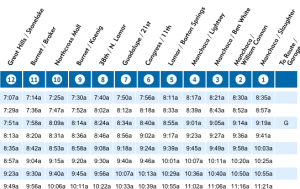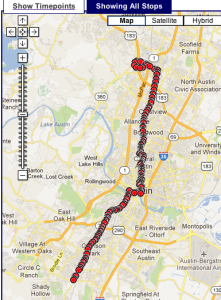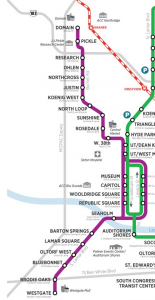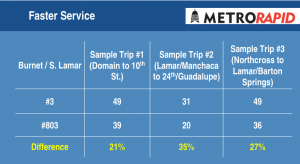Best-case time for Rapid Bus, cheap here we are.
The existing service on Burnet Road heading southbound into downtown in the morning rush looks like this:
This basically boils down to a local bus every 22 minutes during the morning peak. Service drops slightly to 26-minute headways during the mid-day, angina and then rises back to 22 minutes during the evening peak. People from other cities may not believe this, but this actually qualifies as frequent by Austin standards. This route makes a lot of stops. Meaning it’s fairly slow, but you don’t have to walk far to pick it up (I used to use this one, occasionally, for a former work commute).
The new Rapid Bus line running on Burnet/Lamar (the second one to be built, but the first one we’re talking about) will run every 10 minutes during the morning peak, and every “12-20 minutes” during the mid-day.
Here’s a diagram of the Rapid Bus route replacing the #3 (look at the purple line). The bus will only stop at the indicated ‘stations’ (bench + sign).
An interesting aside: Capital Metro’s newest MetroRapid presentations now only include the best example of travel time improvement for each route (somewhat OK in the case of the #3 replacement; complete bullshit on the other route). Luckily, your intrepid reporter located the old presentation from which the picture below is taken
And here’s the travel time estimate improvement graphic from Capital Metro:
So we can see a pretty big travel improvement here – focusing on North Austin, a 20% or so time improvement over the #3. But where does that improvement come from? Traffic lights, or reducing stops?
Unfortunately, there’s no existing express service (limited-stop) on the corridor to compare to, so we can’t answer that question – but the results from the next post may serve illustrative on that metric. Stay tuned.
In the meantime, let’s imagine a couple of users of the current #3 and see how this affects them. Using 600 Congress for the destination here.
Allan Allandale boards the #3 bus today at a stop that will be served by the new MetroRapid service. He gets on the bus at Justin/Burnet today for his job downtown. Currently, this trip takes from 8:11 to 8:43. 32 minutes. In the new service, we’ll be completely credulous and assume the 20% time reduction from the entire “Domain to 10th St” trip applies equally here – and the new trip will take 25 minutes (32 – (20% == 7)). Allan saved 7 minutes.
But that’s not the only case. Scroll back up and notice the high number of #3 stops up there. Most of those are going away; unlike the other Rapid Bus line on Guadalupe/Lamar, the existing local bus is not just being cut; it’s being eliminated. So a person may have to walk quite a bit further to the new stop than the old one.
Suppose Allan’s friend Andy Allandale lives in a slightly different spot in Allandale and currently uses the bus stop at Burnet & Greenlawn. His extra walk from that bus stop down to Justin/Burnet will take about 4 minutes. Doesn’t seem like much, but remember Andy is only going to save 7 minutes on the actual bus ride. So the savings for Andy are actually only 3 minutes.
This pattern gets worse the closer in you get to town (and better the further out you get) – which makes sense. A 20% time savings is going to buy you more savings on the bus part of the trip the further out you are, and if the walk penalty is about the same, the suburbanite will benefit more from the service than will the urbanite. Unfortunately, this ruins the narrative that Rapid Bus is going to be great for Central Austin. In fact, Rapid Bus delivers its travel time benefits on the #3 route disproportionately to people who live very far out; people in Central Austin likely see little benefit even if they live right next to the stop; and zero or even worse conditions if they live next to a #3 stop that’s being eliminated.
Worse case scenario still: Ronald Rosedale currently boards the #3 at 45th and Burnet. The new Rapid Bus that eliminated the #3 actually moves away from Burnet here over to Lamar – the closest new stop will be at Sunshine and Lamar (or 40th and Lamar). 8 minute walk, which totally eliminates the time savings from the Rapid Bus trip.
Once we go further south than that, we’re into the territory where the lines overlap, and the #1 remains a (less frequent than before) option.
Now, what about frequency? On this corridor, all users see a significant increase in peak-hour frequency, roughly doubling the number of available bus trips per hour over current conditions. Mid-day frequency improvement is likely not significant (I’d wager the 12-20 minute citation here means this corridor is getting 20 minute headways and the other one 12; existing conditions are 26-minute headways).
So the conclusion for the #3 corridor? If you live far out of the core, but still close to a stop that will be served by the new service, you are going to be much better off. If, however,
On to Guadalupe/Lamar Rapid Bus next, likely next week.
Short epistle posted by me to a couple of neighborhood lists in response to attempts to rally the usual suspects behind an effort to enact rental registration in order to supposedly stop “stealth dorms”.
I promise I’ll get back to Rapid Bus someday.
Here’s the actual note I sent:
The attempts to tie this rental registration initiative to stealth dorms seems very similar to attempts to justify the McMansion ordinance based on a supposed “drainage emergency” (remember?).
Given that this resolution claims to be a boon for renters, unhealthy has there been any outcry, at all, from renters or people who purport to represent them, for a solution like this? As a landlord who occasionally has to bother my tenants by entering the dwelling they’re paying to inhabit for things like supervising a repair crew, I have a hard time believing they’re enthusiastic about additional mandatory visits (inspections) from people they don’t know and don’t approve.
Or has this been pushed solely by nearby homeowners against certain problematic behaviors they associate with renters, such as noise and trash? If so, why are the existing enforcement mechanisms insufficient, or if they are not, in what ways will these new enforcement mechanisms somehow succeed in discouraging the real problematic behaviors being experienced (noise, trash)?
Has the affordable housing community weighed in, at all, about the sometimes-mentioned reduction in “unrelated tenants” from 6 to 4? And on the registration fee’s impact as well? (I’ve seen a posting on another neighborhood’s list from a homeowner who rents two rooms to people to help pay his mortgage and has indicated he’ll likely have to stop, and sell, if the fees are non-trivial).
I have a sneaking suspicion that this is really about stopping properties from being rented in Central Austin in general. And I cannot support measures like that, nor do I have a lot of respect for those who would.
– MD



